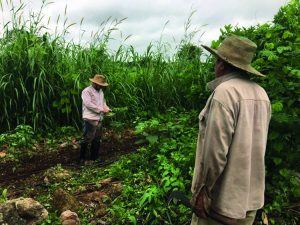We must take the opportunity offered by events to reconfigure the world’s food systems – and that involves seeing them as systems
When we first sat down to conceptualise this issue, we thought about the need to speak to the journey philanthropy has been on when it comes to food systems and where it goes next. 2021 has, in many ways, been the portal, to use Arundhati Roy’s metaphor, between the past, or normal as we knew it, and the opportunity for a new world rooted in equity, justice, resilience and hope. Now what do we do about it?
Each year, philanthropy spends billions on issues which are implicitly connected to food systems – whether that’s environment and nature conservation, or action on climate and planetary health, or human rights, nutrition and sustainable development – but food systems are seldom explicitly addressed in funding strategies.
A work in progress seems like a cliché but it feels right here. 2021 has been a landmark year for awareness and for action on food systems. At the international, national and sub-national process levels, nations and other food system actors gathered at the UN Food Systems Summit 2021, UN Climate Change Conference (COP26), UN Biodiversity Conference (CBD COP15), and the UN Committee on World Food Security. From healthy diets and resilient production practices, to action to stem biodiversity loss and species conservation, to the governance and economics that heavily affect the entire world system, food systems have been at the centre of each of these political agendas.
Unsurprisingly, there have been as many areas of consensus as there have been of deepening schisms and tensions about power, knowledge, representation, corporate influence on government, and all the associated debates about pathways forward. In this context, the clarion call for systems transformation has resounded. And where we go next in this reality has never been more vital.
To help us think critically about the journey so far, evaluation pioneer and systems-thinker Michael Quinn Patton provides a historical look at philanthropy and makes a case that we have been entrenched in siloed thinking to our detriment. He raises the case of a major foundation that had significant yet separate programmes in so-called developing countries all operating independently of each other. He asks ‘what would it look like to create an integrated systems transformation programme?’ and sets out 10 food systems transformation trends to guide future philanthropic engagement.
Systems change work is hard; it challenges the status quo and deep-rooted behaviours and societal norms. It requires a shift in thinking as much as in doing. Even so, there’s no doubt in my mind that, in the last 12 months, we’ve witnessed radical shifts in public awareness. The deeply inequitable impacts of the Covid-19 pandemic and climate change have been reflected in the cross-cutting dysfunctions at the heart of the industrialised food system. Whether pandemics, biodiversity loss, rates of obesity, or the toxic loads carried by farm animals and food system workers alike, people are waking up to how food systems are pushing the planet and our collective health to the limit.
Sectors and industries are responding to this situation. For one, impact investors – as outlined in Rex Raimond and Jennifer Astone’s piece – are looking to de-risk their portfolios through blended finance, insurance and other risk-reduction mechanisms. Donors and others with money on the line are increasingly realising that they need to accept uncertainty, recognise complexity and embrace both short- and long-term approaches to finance and capital. As Raimond and Astone argue, blended finance (the use of government and/or philanthropic capital to leverage private capital) is one of the most powerful levers of change in the funder’s toolbox.
What else is in that toolbox to support the development of systemic solutions? If the reductionist, silo-oriented approach that has dominated much of modern food production and thinking is insufficient and continues to have negative unintended consequences, how do we support more systems thinking and systems-led action – holding tight to the reality that transformation is dynamic, it takes time, is neither straightforward nor linear, and takes trust.
Surely research sits high on the list. Jane Maland Cady of McKnight Foundation’s Collaborative Crop Research Programme (CCRP) agrees and adds that we need a paradigm shift in who we consider ‘experts’, right through to how we conceptualise and validate research and evidence that solves real problems in real contexts. Maland Cady calls for ‘knowledge mutualism’ where every player in the food systems ecology – farmers, scientists, extension programmes, NGOs – brings their skills, strength and experience to create the most useful and innovative solutions.
When it comes to the survival of humanity and the planet, we all have skin in the game; we and our loved ones are in a world that is under threat. We are not outside looking in. We are part of the global system and there’s a good chance that we are each, in our own way, part of the problem. Lukas Haynes and Omar Sana reflect on what this means for philanthropy guided by the notion that foundations have skin in the game and that the philanthropic community has the means to do what others cannot and the public-serving missions that oblige them to do it. They offer a challenge through the example of David Rockefeller Fund’s participation in the UN-convened Net Zero Asset Owner Alliance with a focus on a just transition given that vulnerable and poor people sit at the sharp end of global crises.
If global crises are interconnected, and solutions are underpinned by knowledge and evidence, should that knowledge and evidence not be as interconnected as the problems they are trying to solve?
We only really know global crises through how they affect us on the ground: floods, quarantine, lack of pollinators to fertilise waiting trees, access to land, or not, to feed hungry families. Zulfiquar Haider and Vijay Thallam show us how these issues are showing up in Andhra Pradesh, India in their reflections on ‘Food security, climate change and pandemia’. They provide a hopeful vision of the future based on food systems that prioritise ecological and social resilience as two sides of the same coin. These context- and community-specific agroecological practices deliver health for all, while restoring the integrity of planetary boundaries and upholding participatory approaches to governance and decision-making, with equity and social justice as the non-negotiables for action. They think in terms of legacies, far beyond tomorrow, to generations ahead.
This is such a critical perspective since we know that global systems change must be contextually sensitive and grounded in the interactions between local and global processes and scales of change. We must take into account how people, information, and resources flow from local to global, and global to local, even local to local. From Andhra Pradesh then to the Yucatán Peninsula, Dulce Magaña and Daniel Moss bring us an inspiring example of providing resources to small and agile local grassroots organisations doing essential work on the ground thereby decentralising grantmaking while working in a global context to promote agroecology and food sovereignty.
All contributors to this special feature are, ultimately, questioning how to operate in the ‘new normal’, so it’s no surprise to spot the thread weaving its way through the articles: we can shape the future by imagining the future we want to see. The evidence coming from research, practice, experience and traditional knowledge, social movements and policy arenas is manifold and simple. It leads us to a repaired relationship between people and nature and between people and people. The principles underpinning this relationship – diversity, reciprocity, respect, ensuring there is enough for all, doing no harm – have existed for thousands of years in Indigenous foodways and need to be re-centred in efforts to transform food systems. Fortunately, we have Lourdes Inga and Phrang Roy to help us understand the relationship between biodiverse rich areas, pockets of high cultural diversity, and the number of languages spoken, and the importance of these areas to the future of food, Indigenous and non-Indigenous alike.
The remit of philanthropy has its limits but what philanthropy can do within its legitimate role is situate food systems transformation centrally in the climate, biodiversity, hunger and health agendas, uphold the principles that lead us to a sustainable, equitable, and secure future of food, and utilise all the tools in the philanthropy toolbox from impact investing to collaborative research to recentring agroecology and Indigenous foodways in local, regional, national and international agendas.
As Iara Rolnik – a young, Brazilian woman working in philanthropy and looking to the future – of Instituto Ibirapitanga notes, we must ‘echo critical voices and collaborate in the rebalancing of power. By being open we can blaze new paths. The challenge is great, but the fight is on’.
Ruth Richardson is executive director for Global Alliance for the Future of Food and the Guest Editor of this issue
Email: ruth@futureoffood.org
Twitter: @futureoffoodorg
If you’d like to learn more about this topic, Ruth will be a panellist in Alliance’s virtual event Food systems: time for change. The event will take place on December 7, at 1 pm GMT. You can register to attend here.








Comments (0)